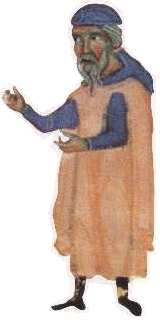
Peire Rogier
Encyclopedia

Troubadour
A troubadour was a composer and performer of Old Occitan lyric poetry during the High Middle Ages . Since the word "troubadour" is etymologically masculine, a female troubadour is usually called a trobairitz....
(fl.
Floruit
Floruit , abbreviated fl. , is a Latin verb meaning "flourished", denoting the period of time during which something was active...
1160 – 1180) and cathedral canon from Clermont
Clermont-Ferrand
Clermont-Ferrand is a city and commune of France, in the Auvergne region, with a population of 140,700 . Its metropolitan area had 409,558 inhabitants at the 1999 census. It is the prefecture of the Puy-de-Dôme department...
. He left his cathedral to become a travelling minstrel
Minstrel
A minstrel was a medieval European bard who performed songs whose lyrics told stories of distant places or of existing or imaginary historical events. Although minstrels created their own tales, often they would memorize and embellish the works of others. Frequently they were retained by royalty...
before settling down for a time in Narbonne
Narbonne
Narbonne is a commune in southern France in the Languedoc-Roussillon region. It lies from Paris in the Aude department, of which it is a sub-prefecture. Once a prosperous port, it is now located about from the shores of the Mediterranean Sea...
at the court of the Viscountess Ermengard. His life and career are known because his late thirteenth-century vida
Vida (Occitan literary form)
Vida is the usual term for a brief prose biography, written in Old Occitan, of a troubadour or trobairitz.The word vida means "life" in Occitan languages. In the chansonniers, the manuscript collections of medieval troubadour poetry, the works of a particular author are often accompanied by a...
survives, as well as some of his works. The reliability of his vida, upon which all the details of his goings and comings are known, however, is not complete. According to it, he left the religious life to become a jongleur.
He fell in love with his hostess and patron and wrote many songs in her honour, giving Ermengard the nickname Tort-n'avetz ("You are wrong"), but for what reasons is unknown. Eventually the people of the Narbonnaise believed that he was in a sexual relationship with the viscountess and so she asked him to leave. He moved on to the court of Raimbaut d'Aurenga, where he also remained for a long time. From Raimbaut's court he moved on to sojourn at that of Alfonso VIII of Castile
Alfonso VIII of Castile
Alfonso VIII , called the Noble or el de las Navas, was the King of Castile from 1158 to his death and King of Toledo. He is most remembered for his part in the Reconquista and the downfall of the Almohad Caliphate...
, then that of Alfonso II of Aragon
Alfonso II of Aragon
Alfonso II or Alfons I ; Huesca, 1-25 March 1157 – 25 April 1196), called the Chaste or the Troubadour, was the King of Aragon and Count of Barcelona from 1164 until his death. He was the son of Ramon Berenguer IV of Barcelona and Petronilla of Aragon and the first King of Aragon who was...
, and finally that of Raymond V of Toulouse
Raymond V of Toulouse
Raymond V was count of Toulouse from 1148 until his death in 1194.He was the son of Alphonse-Jordan. When Alphonse died in the Holy Land in 1148, the county of Toulouse passed to his son Raymond, at the time 14 years old....
, where he arrived circa 1170. According to his vida, he became much esteemed as a troubadour through his travels, but there is no evidence otherwise for any movements in Spain, except perhaps the assembly of troubadours at the court of Aragon mentioned in a work of Peire d'Alvernhe
Peire d'Alvernhe
Peire d'Alvernhe or d'Alvernha was an Auvergnat troubadour with twenty-one or twenty-four surviving works. He composed in an "esoteric" and "formally complex" style known as the trobar clus...
(which need not have taken place). He entered the Order of Grandmont before his death.
Peire Rogier's style of courtly love
Courtly love
Courtly love was a medieval European conception of nobly and chivalrously expressing love and admiration. Generally, courtly love was secret and between members of the nobility. It was also generally not practiced between husband and wife....
poetry is of the extremely reverent variety, in which the man submits completely to his lady and she is a paragon of virtue and courtliness (though the word cortezia is absent from his surviving works). She can by mere words convert a boorish man into a courtly one. Love need not be physical to be enjoyed and suffering on behalf of one's lady is considered pleasure. From one of his works:
Tant ai mon cor en joy assis,
per que no puesc mudar no'n chan,
que joys m'a noirit pauc e gran;
e ses luy non seria res,
qu'assatz vey que tot l'als qu'om fay
abaiss' e sordey' e dechai,
mas so qu'amors e joys soste.
My heart is so fixed on joy
that I cannot help but sin,
for as a child and an adult, joy has nourished me.
Without it, I'd be nothing.
I see that everything else that people do
degrades, dishonours, and defames
if love and joy do nut sustain it.
He has been alleged as the author of the Roman de Flamenca, but as this was written around 1234–1235, he would have done so while about ninety years of age, which is hardly likely. However, the author of the Flamenca probably imitated the dialogue of Peire Rogier's poems. As the originator of internal dialogue in the troubadour lyric, Peire Rogier was also imitated by Guiraut de Bornelh.

